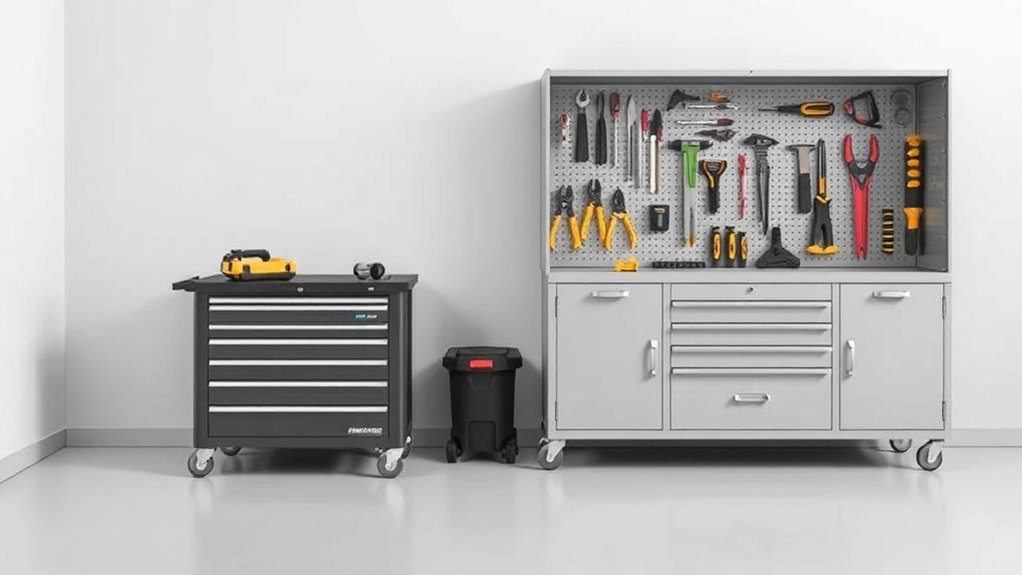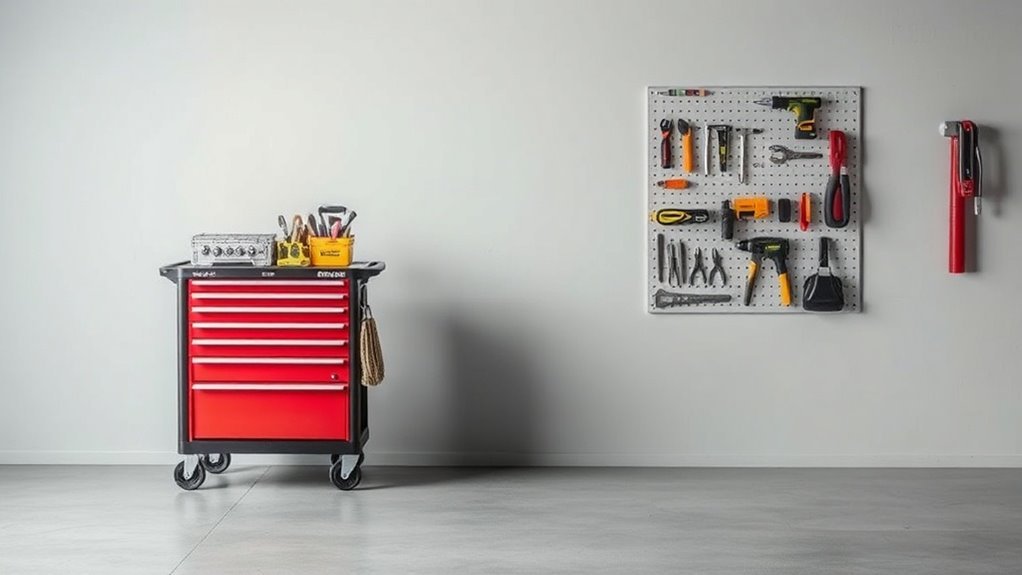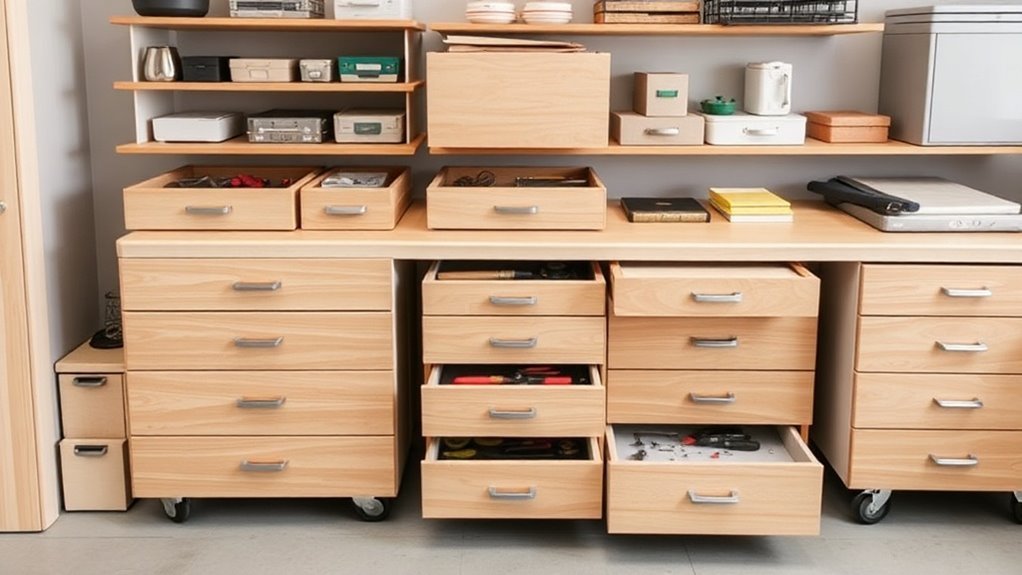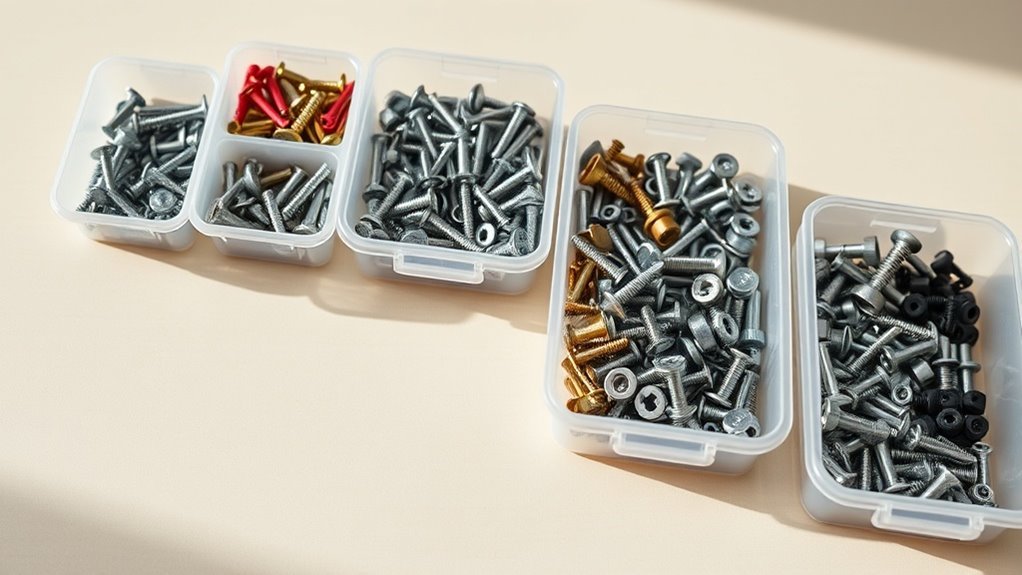Mobile vs. Fixed Tool Storage Explained

When choosing between mobile and fixed tool storage, think about your needs. Mobile storage makes it easy to transport tools and enhances organization on job sites or home projects. However, it might sacrifice stability and security. Fixed storage, on the other hand, offers reliable organization and safety, ideal for workshops and garages. By weighing the pros and cons, you can make an informed decision. Discover more insights that can help you choose the best option for your workspace.
Key Takeaways
- Mobile tool storage enhances portability and is ideal for job sites, while fixed storage offers a stable, permanent solution for organized workspaces.
- Mobile options provide flexibility and easy transport, but may lack stability and security compared to fixed systems.
- Fixed tool storage promotes a clutter-free environment, quick access, and protects tools from theft or damage.
- Consider workspace size and access routes when choosing between mobile and fixed storage to ensure optimal functionality.
- Both storage types can improve efficiency but cater to different needs—mobile for mobility and fixed for stability.
Understanding Mobile Tool Storage
Mobile tool storage refers to equipment designed to hold and transport your tools conveniently, allowing you to work efficiently on various job sites or projects.
These storage solutions come in various forms, from rolling toolboxes to portable tool chests, ensuring you can always have your gear within arm’s reach.
With the ability to move your tools easily, you can shift smoothly between tasks or locations without wasting time rummaging through disorganized containers.
Easily transport your tools to transition between tasks seamlessly and avoid wasting time on disarray.
Additionally, mobile tool storage helps you maintain an organized workspace, reducing clutter and enabling quick access to essential tools. Smart drawer systems can further enhance your organization by providing dedicated spaces for each tool.
Whether you’re a professional or a DIY enthusiast, investing in mobile storage solutions can enhance your workflow and productivity on the job.
Benefits of Mobile Tool Storage

Having tools readily accessible is just one advantage of mobile tool storage. You’ll find that using mobile storage can really enhance your efficiency while tackling projects.
Here are some key benefits:
- Portability: Easily move your tools from one job site to another.
- Organization: Keep your tools neatly arranged, reducing time spent searching.
- Space-saving: Utilize vertical space with stacked solutions for a clutter-free environment.
- Safety: Minimize accidents by securing tools in designated storage rather than leaving them out.
- Flexibility: Adapt your storage system based on the specific needs of each task.
Moreover, modular storage systems can be customized to further optimize your workspace and adapt to various project requirements.
With these advantages, mobile tool storage can profoundly improve your workflow and overall productivity, making it a smart choice for both professionals and DIY enthusiasts.
Drawbacks of Mobile Tool Storage
While mobile tool storage offers flexibility, it comes with some drawbacks. You might find limited stability and security, making it harder to keep your tools safe. Plus, the storage space can feel less organized, leading to frustration when you’re trying to quickly find what you need. Additionally, without proper storage containers, sharp tools may pose a risk to users and can become damaged over time.
Limited Stability and Security
Although mobile tool storage offers convenience, it often falls short regarding stability and security. When you’re constantly on the move, your tools can be more vulnerable to theft and damage.
Here are some key drawbacks to evaluate:
- Limited Locking Mechanisms: Many mobile units lack proper locking features.
- Instability on Rough Terrain: Uneven ground can cause your storage to tip over.
- Transport Risk: Tools may jostle around during transport, risking breakage.
- Easy Access for Thieves: Mobility can make yours an easy target for theft.
- Absence of Permanent Fixture: Without being anchored, these units can be easily moved by anyone.
All these factors make mobile storage less secure and stable compared to fixed options, so careful evaluation is essential.
Less Organized Storage Space
When you rely on mobile tool storage, you might find that organization takes a hit.
Unlike fixed storage, mobile options often come with limited compartments and space, making it easy for tools to shift and clutter. You might spend more time digging through boxes and bags, searching for that specific wrench or drill bit you need.
Plus, since everything’s on the move, tools can get misplaced or even damaged during transportation. Without a dedicated place for each item, you may end up with a chaotic setup that’s frustrating to navigate.
While mobile storage offers convenience, it typically sacrifices organization, which can ultimately hinder your efficiency on the job.
Exploring Fixed Tool Storage
Exploring Fixed Tool Storage
Fixed tool storage offers a reliable solution for those who need a dedicated space to organize and secure their equipment.
It provides a permanent setting that can accommodate various tools and accessories, making your workspace more efficient.
Here’s what to take into account when exploring fixed tool storage:
- Accessibility: Keeps your tools within reach for quick access.
- Organization: Helps sort tools by size, type, or frequency of use.
- Security: Offers protection against theft or damage.
- Space Design: Can be tailored to fit your workspace layout.
- Durability: Built to withstand wear and tear over time.
Furthermore, prioritizing safety in tool storage can enhance both productivity and security in your workspace.
Advantages of Fixed Tool Storage
One of the key advantages of fixed tool storage is its ability to create an organized and efficient workspace, making it easier for you to find and access your tools quickly.
With dedicated space for each tool, you won’t waste time searching through cluttered areas or overflowing boxes. Fixed tool storage also promotes safety; fewer tools lying around reduces the risk of accidents.
Dedicated spaces for tools eliminate clutter and enhance safety, significantly reducing the risk of accidents.
Additionally, since everything has a designated spot, you’re less likely to misplace valuable equipment. This setup not only streamlines your workflow but also enhances productivity. Furthermore, implementing effective small parts storage can further optimize the organization of your workspace.
Fixed systems are often more robust and secure, protecting your tools from theft or damage. Overall, a fixed storage solution creates an environment where you can work with confidence and focus.
Disadvantages of Fixed Tool Storage
While fixed tool storage offers many benefits, it also comes with notable disadvantages. You might find these drawbacks can impact your workflow and efficiency:
- Limited mobility: Once set up, it’s not easy to move your storage around, limiting flexibility.
- Space consumption: Fixed units can take up valuable floor space, especially in smaller work areas.
- Less customization: It may not adapt well to your changing tool collection or storage needs.
- Potential for disorganization: If not properly maintained, tools can become cluttered and harder to locate.
- Costly installation: Fixed systems can require significant investment in both time and money for setup.
Additionally, fixed storage solutions may not adequately protect tools from climate-induced damage, which can lead to rust or deterioration over time.
Factors to Consider When Choosing Storage
When choosing tool storage, you’ll want to think about space availability, how easily you can access your tools, and whether you need mobility.
Each factor plays a key role in finding the right solution for your needs.
Let’s break down how these considerations can impact your decision.
Space Availability
As you assess your storage needs, space availability plays an essential role in determining whether mobile or fixed tool storage is the best fit for you. Here are some factors to take into account:
- Workspace Size: Measure your available area to guarantee your storage solution fits without crowding.
- Access Routes: Check for any obstructions that could complicate moving or retrieving tools.
- Storage Density: Decide how many tools you need to store and plan for adequate space.
- Flexibility: Reflect on if you’ll need to reconfigure workspace layout in the future.
- Safety: Verify that your chosen storage method doesn’t create hazards or block fire exits.
Evaluating these points can help you make a more informed decision about your tool storage needs.
Tool Accessibility
Considering how easily you can access your tools can considerably influence your choice between mobile and fixed storage options. If you’re frequently using certain tools, having them easily reachable in a fixed setup might be best.
Think about how often you’d need to grab specific items during projects. With fixed storage, everything stays organized in one place, which can save you time and confusion.
On the other hand, mobile storage provides flexibility. If you’re often moving between jobs or different areas, having tools stored in a mobile unit allows you quick access wherever you are.
It’s essential to evaluate your workflow and consider what’ll enhance efficiency. Ultimately, your choice should align with how and when you access your tools.
Mobility Requirements
While you might prioritize accessibility, mobility is just as important when selecting your tool storage.
Think about how often you’ll need to move your tools and where you’ll be using them. A few factors to contemplate include:
- Weight: Heavier storage might require more effort to transport.
- Wheels: Opt for sturdy wheels that roll smoothly over different surfaces.
- Size: Choose a compact design if you’ll be maneuvering tight spaces.
- Locking Mechanisms: Confirm your storage can be secured in transit.
- Durability: Look for materials that withstand wear and tear, especially if you’re on the go.
Use Cases for Mobile Tool Storage
Why should you choose mobile tool storage over fixed options? When you need flexibility on the job site, mobile tool storage becomes essential. It allows you to transport tools and materials seamlessly, whether you’re working on a home renovation or responding to emergency repairs.
Here’s a quick look at some use cases for mobile tool storage:
| Use Case | Advantages | Ideal Tools |
|---|---|---|
| Job Sites | Easy transport to multiple locations | Power tools, hand tools |
| Home Projects | Simplifies organization at home | DIY tools, accessories |
| Repairs & Maintenance | Quick access during service calls | Diagnostic tools |
| Events & Exhibits | Portable display options | Demo tools, samples |
With mobile storage, you get efficiency and convenience where you need it most!
Use Cases for Fixed Tool Storage
When you think about fixed tool storage, it’s essential to contemplate its practical applications.
Whether in your workshop, a garage, or an industrial setting, having a dedicated space for tools can improve organization and efficiency.
Plus, for home improvement projects, fixed storage keeps everything you need within easy reach, making your tasks smoother.
Workshops and Garages
In many workshops and garages, fixed tool storage is essential for maintaining organization and accessibility. When you’re focused on a project, the last thing you want is to waste time searching for tools. Fixed storage solutions help you keep everything in its place, making your workflow more efficient.
Here are some key benefits:
- Space Optimization: Maximize vertical and horizontal space.
- Easy Access: Tools are readily available without clutter.
- User Safety: Reduces risks of accidents by keeping tools organized.
- Time Savings: Find what you need quickly, minimizing downtime.
- Durability: Built to withstand heavy use and protect your tools.
Investing in fixed tool storage will streamline your work in the garage, letting you focus on your projects with less hassle.
Industrial Settings
Fixed tool storage isn’t just beneficial for home workshops and garages; it’s also essential in industrial settings. In factories, assembly lines, and warehouses, having a designated space for tools helps maintain order and efficiency. You won’t have to waste time searching for the right tool when they’re organized in fixed storage units.
These systems can withstand the wear and tear of industrial environments, ensuring your tools are safe and accessible. Additionally, fixed tool storage can enhance safety, minimizing the risk of accidents caused by misplaced tools.
You can also customize storage solutions to fit your specific needs, whether it’s tool cabinets, shelves, or pegboards. In high-demand settings, these advantages lead to increased productivity and streamlined workflows.
Home Improvement Projects
Whether you’re tackling a small DIY project or a major renovation, having organized fixed tool storage makes all the difference in your efficiency and effectiveness.
A well-structured storage solution allows you to easily access everything you need, saving valuable time and reducing frustration.
Consider these benefits of fixed tool storage for your home improvement projects:
- Keeps tools organized and accessible
- Reduces time spent searching for items
- Enhances safety by minimizing clutter
- Protects tools from damage and wear
- Facilitates project planning and execution
With fixed storage, you’ll find that your workspace isn’t only more functional but also encourages better workflow.
Invest in a system that works for you, and watch your project’s success soar.
Making the Right Choice for Your Workspace
Choosing between mobile and fixed tool storage can feel overwhelming, especially when considering the unique demands of your workspace.
First, think about how often you need to move tools around. If you’re working on different projects across various locations, mobile storage might be your best bet. On the other hand, if your workspace is more static, fixed storage can provide a sturdy and organized solution.
Next, consider the space available. Do you have room for cabinets, or would a rolling cart make better use of your area?
Finally, assess your tool collection size. If you own many tools, a combination of both options might work best, giving you flexibility while keeping everything organized.
Make the choice that fits your workflow!
Questions
How Do I Maintain My Mobile Tool Storage Units?
To maintain your mobile tool storage units, regularly clean them, check for wear and tear, guarantee wheels roll smoothly, and organize tools to prevent clutter. Don’t forget to secure them when not in use!
What Materials Are Commonly Used in Fixed Tool Storage Systems?
Think of sturdy steel, warm wood, and resilient plastic. You’ll find these materials in fixed tool storage systems, offering durability and style. They’re designed to withstand the test of time while keeping your tools safe and organized.
Can Mobile Tool Storage Be Customized?
Yes, you can customize mobile tool storage options. Many manufacturers offer various sizes, colors, and configurations. You can also add accessories like organizers and dividers to suit your unique needs and preferences.
What Is the Weight Capacity of Mobile Tool Storage?
Think of mobile tool storage as a sturdy ship maneuvering your workspace; it typically holds between 200 to 600 pounds, depending on the design and materials. You’ll want to check specifications to optimize your setup!
Are There Specific Brands Known for Quality Fixed Tool Storage?
Yes, there are specific brands known for quality fixed tool storage. You might consider brands like Gladiator, Husky, or Craftsman, as they consistently receive positive reviews for durability, organization, and functionality in fixed tool storage solutions.
Conclusion
In the end, choosing between mobile and fixed tool storage boils down to your specific needs. If you’re constantly on the move, mobile storage might just be the ticket. However, if you value organization and easy access, fixed storage could be your best bet. Whichever route you take, remember that the right storage will keep your workspace running like a well-oiled machine. So, weigh your options wisely, and you’ll hit the ground running!






